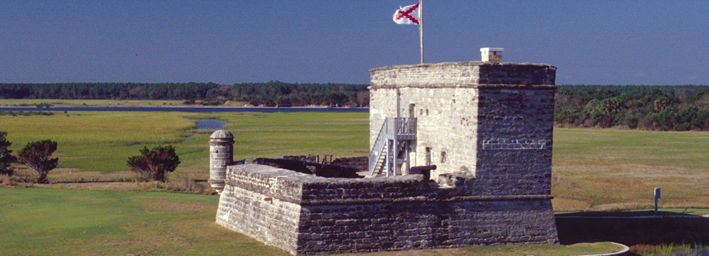As early as 1569 the Spanish recognized the vulnerability of the Matanzas Inlet and built a wooden watchtower without armament and a thatched hut to house six soldiers who took turns scanning the horizon. If a ship was sighted, a runner or small boat set out to warn St. Augustine. At least twice the watchtower kept pirates from coming in this "backdoor". In 1683 English outlaws captured the watchtower, but word made it to St. Augustine, and ships and soldiers came and drove them off. In 1686 French pirates attempted to come into the inlet, but again word was sent to St. Augustine, and these pirates, too, were repulsed.
Work started on the tower in the fall of 1740. Coquina stone was quarried at El Piñon, a small inlet south of Matanzas. Construction was difficult, for long piles had to be driven into the marsh to support rising stonework. Repeatedly, the British and their Indian allies tried to stop construction. But by 1742 the coquina structure was completed, including armaments. In September of that year, the British tried again to enter through the Matanzas Inlet. Fort Matanzas was completed and fired its cannon. The British retreated without firing a shot. The rest of the story-- The king must have forgiven Governor Manuel de Montiano for his failure to go through proper channels. In 1751 Montiano was awarded the governorship of Panama, a very wealthy colony compared to St. Augustine and Florida. He died there in 1758. Click here for more information.
Visitor Tip
44 miles: heading south on the byway.
Points Of Interest
- Ponte Vedra Beach
- Bird Island Park
- Mickler’s Landing
- Guana Tolomato Matanzas
- Guana Tolomato Matanzas Environmental Ed Center
- Nease Beachfront Park
- Vilano Beach
- Colonial St. Augustine
- St. Augustine
- The Flagler Factor
- America’s Tourism Capital 1890-1930
- Anastasia Island
- Fort Matanzas – National Monument
- Marineland and UF Whitney Lab
- Washington Oaks Gardens State Park
- Malacompra Plantation Archaeological Site
- Betty Steflik Memorial Reserve
- Flagler Beach Pier
- Gamble Rogers Memorial State Park

